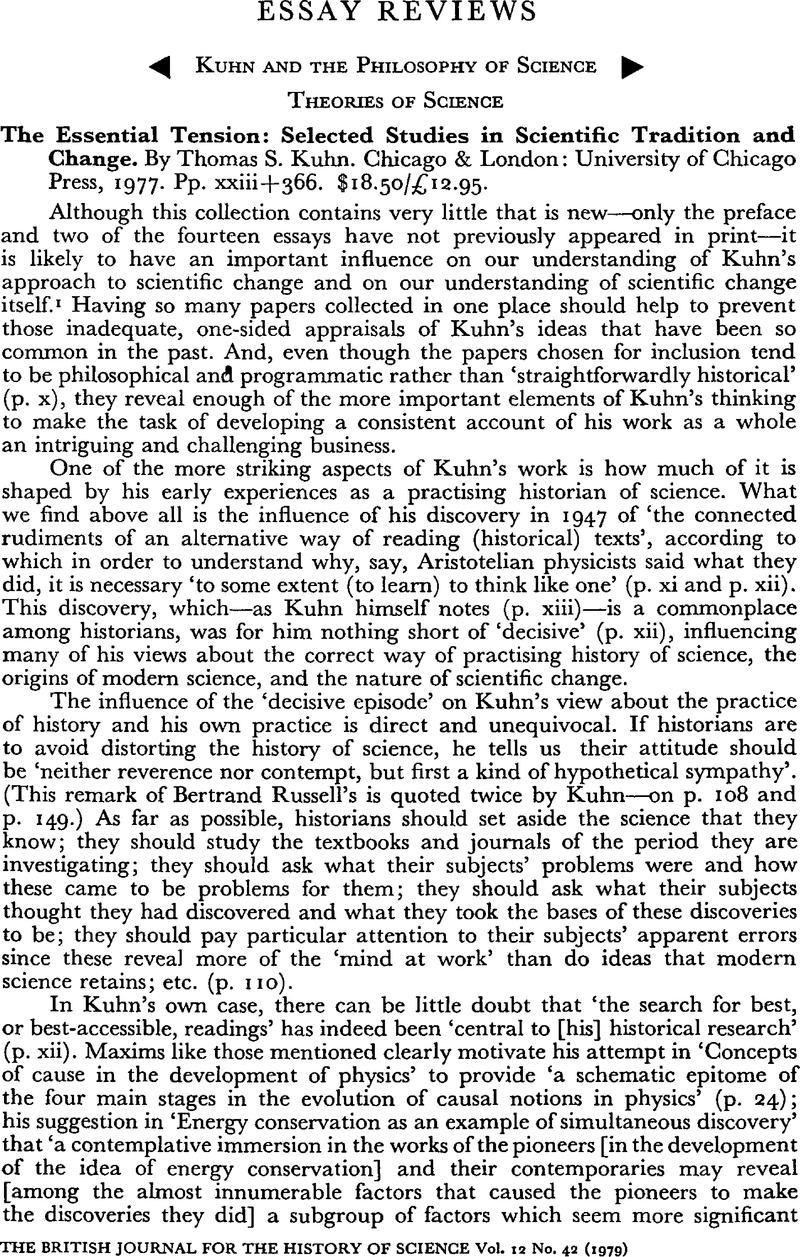Published online by Cambridge University Press: 05 January 2009

1 The collection comprises ‘The relations between the history and the philosophy of science’ (1968, revised 1976), pp. 3–20Google Scholar; ‘Concepts of cause in the development of physics’ (1971), pp. 21–30Google Scholar; ‘Mathematical versus experimental traditions in the development of physical science’ (1976), pp. 31–65Google Scholar; ‘Energy conservation as an example of simultaneous discovery’ (1959), pp. 66–104Google Scholar; ‘The history of science’ (1968), pp. 105–26Google Scholar; ‘The relations between history' and the history of science’ (1971), pp. 127–61Google Scholar; ‘The historical structure of scientific discovery’ (1962), pp. 165–77Google Scholar; ‘The function of measurement in modern physical science’ (1961), pp. 178–224Google Scholar; ‘The essential tension: tradition and innovation in scientific research’ (1959), pp. 225–39Google Scholar; ‘A function for thought experiments’ (1964), pp. 240–65Google Scholar; ‘Logic of discovery or psychology of research’ (1970), pp. 266–92Google Scholar; ‘Second thoughts on paradigms’ (1974), pp. 293–319Google Scholar; ‘Objectivity, value judgement, and theory choice’ (1973), pp. 320–39Google Scholar; and ‘Comment on the relations of science and art’ (1969), pp. 340–52.Google Scholar Only the first and the penultimate essays have not previously appeared in print.
2 Kuhn, T. S., The Copernican revolution, Cambridge, Mass., 1957, p. viii.Google Scholar
3 Butterfield, H., The whig interpretation of history, London, 1931, p. 13.Google Scholar
4 Lakatos, I., ‘History of science and its rational reconstructions’, Boston studies in the philosophy of science, 1971, 8, 91.CrossRefGoogle Scholar
5 Kuhn, T. S., ‘Notes on Lakatos’Google Scholar, ibid., p. 143.
6 Butterfield, H., The origins of modern science, 2nd edn., London, 1957, pp. 1, 7.Google Scholar
7 Cf., for example, Kemsley, D., ‘Religious influences in the rise of modern science’, Annals of science, 1968, 24, 199–226.CrossRefGoogle Scholar
8 The idea that there is an essential tension in science between tradition and innovation is not stated unequivocally in ‘The essential tension’. This is not particularly surprising, the essay being prepared within a month or so of Kuhn's recognition of the utility of the notion of a paradigm (cf. p. xix). In addition, it should also be noted that the idea does not, as one might expect, only appear in Kuhn's work prior to The structure of scientific revolutions: it can also be discerned in ‘The function of dogma in scientific research’, which was written after the first draft of the book was completed (cf. Crombie, A. C. (ed.), Scientific change, London, 1961, p. 368)Google Scholar. In The structure of scientific revolutions, 2nd edn., Chicago, 1970Google Scholar, Kuhn refers to ‘the essential tension implicit in science’ (p. 79), but views it as a characteristic of extraordinary science, not of science in general.
9 Kuhn, T. S., The structure of scientific revolutions, op. cit. (8), p. xiii.Google Scholar
10 Feyerabend, P. K., ‘Consolations for the specialist’, in Lakatos, I. and Musgrave, A. (eds.), Criticism and the growth of knowledge, Cambridge, 1970, p. 212. Feyerabend's italics.Google Scholar
11 Buchdahl, G., ‘History of science and criteria of choice’, Minnesota studies in the philosophy of science, 1970, 5, section I.Google Scholar
12 Kuhn, T. S., ‘Postscript—1969’, in The structure of scientific revolutions, op. cit. (8), pp. 178, 181.Google Scholar
13 Ibid., p. 179.
14 Ibid., pp. 200–4.
15 Ibid., p. 172.
16 Kuhn, T. S., ‘Reflections on my critics’Google Scholar, in Lakatos, and Musgrave, (eds.), op. cit. (10), p. 241.Google Scholar
17 For further discussion and criticism along these lines see Shapere, D., ‘The paradigm concept’, Science, 1971, 172, 708.Google Scholar